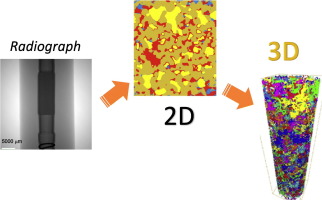Advances in Colloid and Interface Science ( IF 15.6 ) Pub Date : 2017-12-28 , DOI: 10.1016/j.cis.2017.12.009 Stefan Iglauer , Maxim Lebedev

|
Physical, chemical and mechanical pore-scale (i.e. micrometer-scale) mechanisms in rock are of key importance in many, if not all, subsurface processes. These processes are highly relevant in various applications, e.g. hydrocarbon recovery, CO2 geo-sequestration, geophysical exploration, water production, geothermal energy production, or the prediction of the location of valuable hydrothermal deposits. Typical examples are multi-phase flow (e.g. oil and water) displacements driven by buoyancy, viscous or capillary forces, mineral-fluid interactions (e.g. mineral dissolution and/or precipitation over geological times), geo-mechanical rock behaviour (e.g. rock compaction during diagenesis) or fines migration during water production, which can dramatically reduce reservoir permeability (and thus reservoir performance).
All above examples are 3D processes, and 2D experiments (as traditionally done for micro-scale investigations) will thus only provide qualitative information; for instance the percolation threshold is much lower in 3D than in 2D. However, with the advent of x-ray micro-computed tomography (μCT) – which is now routinely used – this limitation has been overcome, and such pore-scale processes can be observed in 3D at micrometer-scale. A serious complication is, however, the fact that in the subsurface high pressures and elevated temperatures (HPET) prevail, due to the hydrostatic and geothermal gradients imposed upon it. Such HPET-reservoir conditions significantly change the above mentioned physical and chemical processes, e.g. gas density is much higher at high pressure, which strongly affects buoyancy and wettability and thus gas distributions in the subsurface; or chemical reactions are significantly accelerated at increased temperature, strongly affecting fluid-rock interactions and thus diagenesis and deposition of valuable minerals.
It is thus necessary to apply HPET conditions to the aforementioned μCT experiments, to be able to mimic subsurface conditions in a realistic way, and thus to obtain reliable results, which are vital input parameters required for building accurate larger-scale reservoir models which can predict the overall reservoir-scale (hectometer-scale) processes (e.g. oil production or diagenesis of a formation).
We thus describe here the basic workflow of such HPET-μCT experiments, equipment requirements and apparatus design; and review the literature where such HPET-μCT experiments were used and which phenomena were investigated (these include: CO2 geo-sequestration, oil recovery, gas hydrate formation, hydrothermal deposition/reactive flow). One aim of this paper is to give a guideline to users how to set-up a HPET-μCT experiment, and to provide a quick overview in terms of what is possible and what not, at least up to date.
As a conclusion, HPET-μCT is a valuable tool when it comes to the investigation of subsurface micrometer-scaled processes, and we expect a rapidly expanding usage of HPET-μCT in subsurface engineering and the subsurface sciences.
中文翻译:

地下应用的高压X射线微计算机断层扫描
在许多(如果不是全部)地下过程中,岩石的物理,化学和机械孔隙尺度(即微米尺度)机制至关重要。这些过程在各种应用中具有高度相关性,例如烃采收,CO 2固存,地球物理勘探,水生产,地热能生产或对有价值的热液矿床位置的预测。典型的例子是由浮力,粘性或毛细作用力驱动的多相流(例如油和水)位移,矿物-流体相互作用(例如,地质时期内的矿物溶解和/或沉淀),岩土力学行为(例如,岩石压实期间成岩作用)或在产水过程中进行精细运移,这会显着降低储层渗透率(从而降低储层性能)。
以上所有示例都是3D过程,因此2D实验(传统上是进行微观调查的)只能提供定性信息;例如3D中的渗漏阈值比2D中的低得多。但是,随着现在通常使用的X射线计算机断层扫描(μCT)的出现,这一局限性已被克服,并且可以在微米级的3D模式下观察到这种孔尺度过程。然而,由于施加在其上的静水压力和地热梯度,在地下存在着高压和高温(HPET)这一事实,这是一个严重的问题。这种HPET储层条件极大地改变了上述物理和化学过程,例如高压下的气体密度要高得多,这会严重影响浮力和润湿性,从而影响地下气体的分布;或化学反应在升高的温度下会显着加速,从而强烈影响流体与岩石的相互作用,从而影响有价值的矿物的成岩作用和沉积。
因此,有必要将HPET条件应用于上述μCT实验,以便能够以逼真的方式模拟地下条件,并因此获得可靠的结果,这是建立可预测的精确大型储层模型所需的重要输入参数。整个储层规模(百米规模)过程(例如,石油生产或地层成岩作用)。
因此,我们在此描述此类HPET-μCT实验的基本工作流程,设备要求和设备设计。并回顾使用此类HPET-μCT实验并研究了哪些现象的文献(包括:CO 2固存,采油,天然气水合物形成,水热沉积/反应流)。本文的目的之一是为用户提供如何建立HPET-μCT实验的指南,并就至少是最新的可行和不可行提供快速概述。
结论是,HPET-μCT是研究地下微米级过程的有价值的工具,我们期望HPET-μCT在地下工程和地下科学中的应用迅速扩展。



























 京公网安备 11010802027423号
京公网安备 11010802027423号